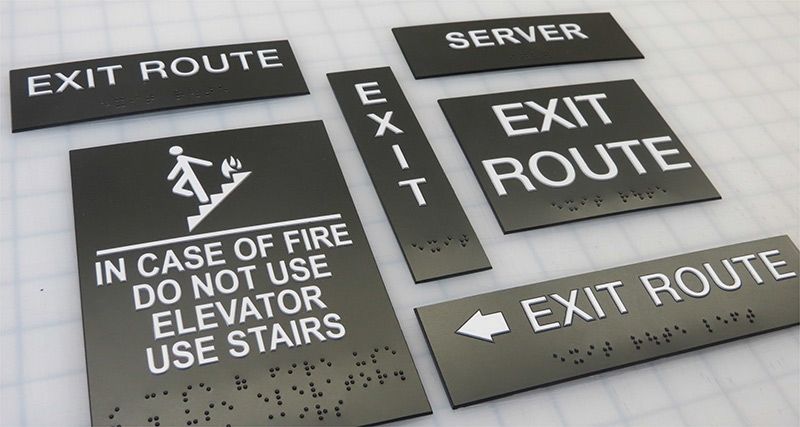A Comprehensive Overview to Selecting the Right ADA Signs
A Comprehensive Overview to Selecting the Right ADA Signs
Blog Article
Checking Out the Trick Attributes of ADA Indicators for Improved Accessibility
In the realm of availability, ADA signs serve as quiet yet powerful allies, making sure that rooms are inclusive and navigable for people with disabilities. By incorporating Braille and responsive elements, these indications damage barriers for the visually impaired, while high-contrast shade schemes and clear typefaces cater to varied aesthetic needs.
Significance of ADA Conformity
Ensuring compliance with the Americans with Disabilities Act (ADA) is crucial for promoting inclusivity and equivalent accessibility in public rooms and workplaces. The ADA, passed in 1990, mandates that all public facilities, companies, and transport solutions suit individuals with specials needs, guaranteeing they enjoy the same legal rights and possibilities as others. Conformity with ADA criteria not only fulfills legal obligations however likewise boosts a company's online reputation by demonstrating its commitment to diversity and inclusivity.
One of the key facets of ADA conformity is the application of accessible signs. ADA indications are developed to ensure that people with specials needs can quickly navigate via areas and buildings.
In addition, adhering to ADA policies can minimize the threat of lawful consequences and potential penalties. Organizations that fail to abide with ADA guidelines might face penalties or claims, which can be both destructive and economically challenging to their public picture. Hence, ADA compliance is indispensable to fostering a fair environment for everybody.
Braille and Tactile Components
The incorporation of Braille and tactile aspects into ADA signs personifies the concepts of access and inclusivity. It is generally put underneath the matching message on signs to make certain that people can access the details without aesthetic assistance.
Responsive elements expand beyond Braille and include raised characters and icons. These elements are developed to be discernible by touch, allowing people to recognize space numbers, washrooms, exits, and various other critical locations. The ADA sets particular guidelines pertaining to the dimension, spacing, and placement of these tactile components to enhance readability and make sure consistency throughout various settings.

High-Contrast Color Design
High-contrast shade plans play a pivotal function in enhancing the presence and readability of ADA signage for people with visual problems. These schemes are crucial as they optimize the difference in light reflectance in between text and background, ensuring that indications are conveniently noticeable, also from a distance. The Americans with Disabilities Act (ADA) mandates using certain color contrasts to fit those with minimal vision, making it a crucial element of conformity.
The effectiveness of high-contrast shades lies in their capacity to stand out in different helpful resources lights conditions, consisting of poorly lit environments and locations with glow. Generally, dark message on a light history or light text on a dark background is used to attain optimal contrast. As an example, black message on a white or yellow background provides a stark visual distinction that assists in fast recognition and comprehension.

Legible Fonts and Text Dimension
When thinking about the design of ADA signage, the selection of understandable fonts and suitable text dimension can not be overemphasized. The Americans with Disabilities Act (ADA) mandates that here are the findings font styles should be sans-serif and not italic, oblique, manuscript, extremely ornamental, or of unusual kind.
According to ADA standards, the minimal text height need to be 5/8 inch, and it must enhance proportionally with viewing range. Consistency in text dimension adds to a natural visual experience, aiding people in browsing settings effectively.
Furthermore, spacing in between letters and lines is important to legibility. Appropriate spacing avoids personalities from appearing crowded, improving readability. By sticking to these standards, developers can go to the website considerably improve ease of access, making certain that signage serves its desired purpose for all individuals, no matter their visual abilities.
Reliable Positioning Techniques
Strategic positioning of ADA signs is important for maximizing availability and making certain compliance with legal requirements. Appropriately located signs direct individuals with specials needs properly, facilitating navigation in public spaces. Secret factors to consider consist of presence, closeness, and elevation. ADA standards state that indicators must be placed at an elevation in between 48 to 60 inches from the ground to guarantee they are within the line of sight for both standing and seated individuals. This common elevation variety is important for inclusivity, allowing wheelchair individuals and individuals of varying heights to accessibility details easily.
Furthermore, indicators have to be put adjacent to the lock side of doors to allow very easy identification prior to entry. Uniformity in sign positioning throughout a facility boosts predictability, decreasing complication and improving total user experience.

Conclusion
ADA indications play an essential role in promoting availability by incorporating features that deal with the demands of individuals with impairments. Integrating Braille and responsive elements guarantees vital details is accessible to the visually impaired, while high-contrast shade plans and understandable sans-serif fonts enhance visibility across various illumination conditions. Effective positioning strategies, such as appropriate installing heights and calculated areas, better facilitate navigating. These elements jointly foster an inclusive environment, underscoring the importance of ADA compliance in ensuring equal access for all.
In the world of ease of access, ADA signs serve as quiet yet effective allies, guaranteeing that spaces are accessible and inclusive for people with impairments. The ADA, enacted in 1990, mandates that all public centers, companies, and transportation solutions fit individuals with handicaps, guaranteeing they delight in the same civil liberties and chances as others. ADA Signs. ADA signs are made to make sure that individuals with handicaps can quickly browse with buildings and rooms. ADA standards stipulate that indicators ought to be mounted at an elevation between 48 to 60 inches from the ground to guarantee they are within the line of sight for both standing and seated people.ADA signs play an essential function in advertising ease of access by incorporating functions that resolve the requirements of individuals with specials needs
Report this page